
Myliobatiformes is one of the four orders of batoids, cartilaginous fishes related to sharks. They were formerly included in the order Rajiformes, but more recent phylogenetic studies have shown the myliobatiforms to be a monophyletic group, and its more derived members evolved their highly flattened shapes independently of the skates.

The guitarfish, also referred to as shovelnose rays, are a family, Rhinobatidae, of rays. The guitarfish are known for an elongated body with a flattened head and trunk and small, ray-like wings. The combined range of the various species is tropical, subtropical, and warm temperate waters worldwide.
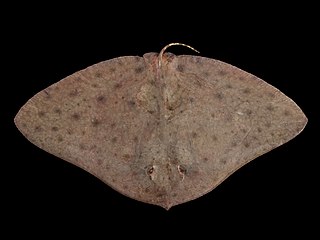
The butterfly rays are the rays forming the genus Gymnura and the family Gymnuridae. They are found in warm oceans worldwide, and occasionally in estuaries.

Rhinobatos is a genus of fish in the Rhinobatidae family. Although previously used to encompass all guitarfishes, it was found to be polyphyletic, and recent authorities have transferred many species included in the genus to Acroteriobatus, Glaucostegus, and Pseudobatos.
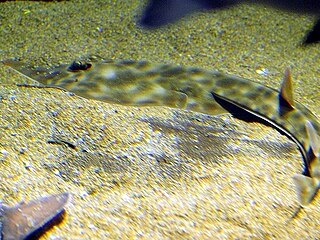
The brown guitarfish is a species of fish in the Rhinobatidae family. It is found in western Pacific of Taiwan and the Philippines. Its natural habitats are open seas, shallow seas, coral reefs, and estuarine waters. The Taiwan guitarfish was formerly considered a distinct species, but is now considered a junior synonym.
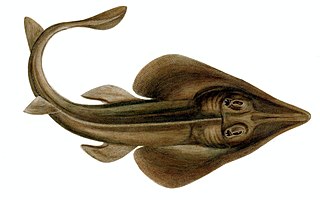
The Brazilian guitarfish is a species of fish in the family Rhinobatidae. It is endemic to Brazil, where its natural habitat is coastal waters on the continental shelf. This fish is viviparous and has a long gestation period, concluding with the birth of live pups in February. At this time the fish are subject to intense fishing activity but catches have been dwindling in recent years as a result of overfishing. Because so few breeding-size fish remain, the International Union for Conservation of Nature has assessed the fish's conservation status as being "critically endangered".
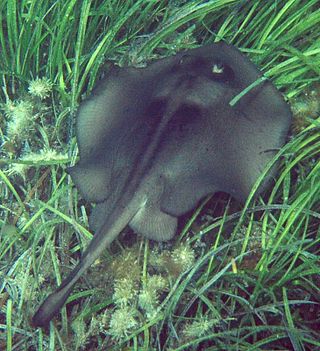
Trygonoptera is a genus of round rays endemic to the waters around Australia. Müller and Henle defined Trygonoptera in 1841. It has often been considered synonymous with Urolophus, but this has been refuted by recent studies. Trygonoptera can be distinguished from Urolophus in that the outer rims of its nostrils are enlarged into broad, flattened lobes; the two also differ in aspects of the skeleton.

Urolophus is a genus of round rays mostly native to the western Pacific Ocean and the Indian Ocean, though one species occurs in the Pacific waters of the Mexican coast. Müller and Henle erected Urolophus in an 1837 issue of Bericht Akademie der Wissenschaften zu Berlin. The name is derived from the Greek oura, meaning "tail", and lophos, meaning "crest". In Urolophus, the outer rims of the nostrils are not enlarged into lobes, but may form a small knob at the back.
Tarsistes philippii is a taxonomically dubious species of guitarfish, family Rhinobatidae. It is known only from a dried head from the Juan Fernández Islands off Chile. The head had a long, thin, flat snout, rounded at the tip like that of the goblin shark, and the underside covered with small stellate prickles except for the base. The head was covered with larger spinules, with six still larger ones forming a curve around the eye.

Neotrygon is a genus of stingrays in the family Dasyatidae commonly known as the Maskrays, native to the Indo-West Pacific. They are so named because of a distinctive color pattern around their eyes, resembling a mask. The species in this genus were originally placed in the genus Dasyatis by most authors. However, recent morphological and molecular analyses have conclusively showed that they represent a distinct group and so the genus Neotrygon was resurrected for them.

Wedgefishes are rays of the family Rhinidae, comprising eleven species in three genera. Classified in the order Rhinopristiformes along with guitarfishes and sawfishes, they have also been known as giant guitarfishes or sharkfin guitarfishes.
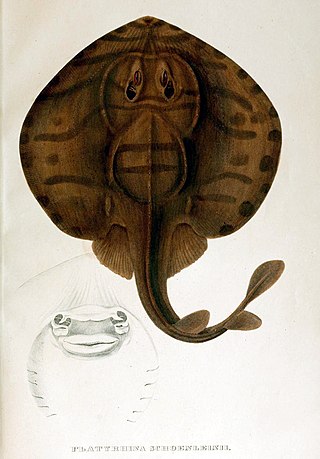
The striped panray is a species of ray in the family Zanobatidae. It was considered the only species in its genus and family until the description of the maculate panray in 2016.

Glaucostegus, also known as giant guitarfishes, is a genus of large Indo-Pacific rays, with a single species, Glaucostegus cemiculus, in the East Atlantic, and Mediterranean. They were formerly classified in the family Rhinobatidae but are now recognized as a distinct family, Glaucostegidae.

Hemitrygon is a genus of stingrays in the family Dasyatidae from marine, brackish and freshwater habitats in the central Indo-Pacific and northwest Pacific regions. The genus was formerly regarded as a junior synonym of the genus Dasyatis.

Rhinopristiformes is an order of rays, cartilaginous fishes related to sharks, containing shovelnose rays and allied groups.

Trygonorrhinidae, the banjo rays, is a family of rays, comprising eight species in three genera. They were formerly classified in the family Rhinobatidae.

The panrays are a genus, Zanobatus, of rays found in coastal parts of the warm East Atlantic Ocean, ranging from Morocco to Angola. It is the only genus in the family Zanobatidae, which traditionally has been included in the Myliobatiformes order, but based on genetic evidence it is now in Rhinopristiformes or a sister taxon to Rhinopristiformes.

Pseudobatos is a genus of fish in the Rhinobatidae family. Although its constituent species were previously assigned to Rhinobatos, recent authors treat it as distinct.
















